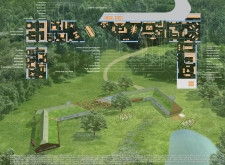5 key facts about this project
This project represents a balance between wellness and environmental consciousness, focusing on creating a serene atmosphere where guests can rejuvenate and reflect. Central to its function is the emphasis on relaxation and community, with spaces designed to foster both private retreats and social interactions. The architectural layout accommodates various activities, ranging from spa treatments to communal dining, ensuring that every space within the hotel serves a meaningful purpose.
The architectural design of the Blue Clay Country Spa Hotel incorporates various important elements that enhance its overall functionality and aesthetic appeal. The use of blue clay, a material native to the region, allows the hotel to remain intimately connected to its geographical identity. This local material not only provides excellent thermal properties but also resonates with cultural significance, reflecting the area's traditional building practices. The warmth of blue clay is complemented by natural timber that frames the building, bringing additional texture and inviting warmth to the overall design.
The roofs of the hotel feature pitched angles that not only reference traditional Latvian architecture but also serve practical purposes. They are designed to effectively handle rainwater runoff, while the varied heights create visual interest and contribute to the integration with the natural landscape. The extensive use of glass throughout the design maximizes natural light, reinforcing the connection between the indoor environment and the beauty of the outdoors. Large windows and strategically placed glass walls invite views of the surrounding nature, creating a tranquil and uplifting ambiance within the hotel's spaces.
The interior layout emphasizes openness and flow, with communal lounges and treatment areas designed to enhance the guest experience. The layouts encourage interaction while still allowing for private moments of solitude. Outdoor areas are seamlessly connected to the indoors, blurring the lines between the two and inviting guests to engage with the natural environment. Features such as pathways leading to green spaces and relaxation areas encourage exploration and foster a deep connection with the hotel's tranquil setting.
Sustainability is a foundational aspect of the hotel’s design approach. By utilizing locally sourced materials like blue clay and timber, the project minimizes its carbon footprint and promotes a dialogue with the local environment. Green roofs are another key feature, serving to insulate the building while also supporting local biodiversity. These sustainable practices are not just a design choice but also reflect a broader commitment to ecological responsibility, ensuring that the hotel contributes positively to its setting.
Unique design approaches are evident in how the project synthesizes contemporary architectural ideas with traditional elements. The emphasis on wellness is not solely about physical health; it encompasses emotional and mental well-being as well. The layout and design integrate natural elements, light, and space to create an environment conducive to relaxation and rejuvenation.
For those interested in exploring the intricacies of this architectural project, the presentation offers detailed insights into architectural plans, sections, and concepts that underpin the design. By reviewing these elements, readers can gain a deeper understanding of how the Blue Clay Country Spa Hotel stands as a model of thoughtful architectural practice, rooted in both place and purpose. This project encapsulates the essence of integrating form, function, and cultural significance within contemporary architecture, inviting further exploration and appreciation.


























